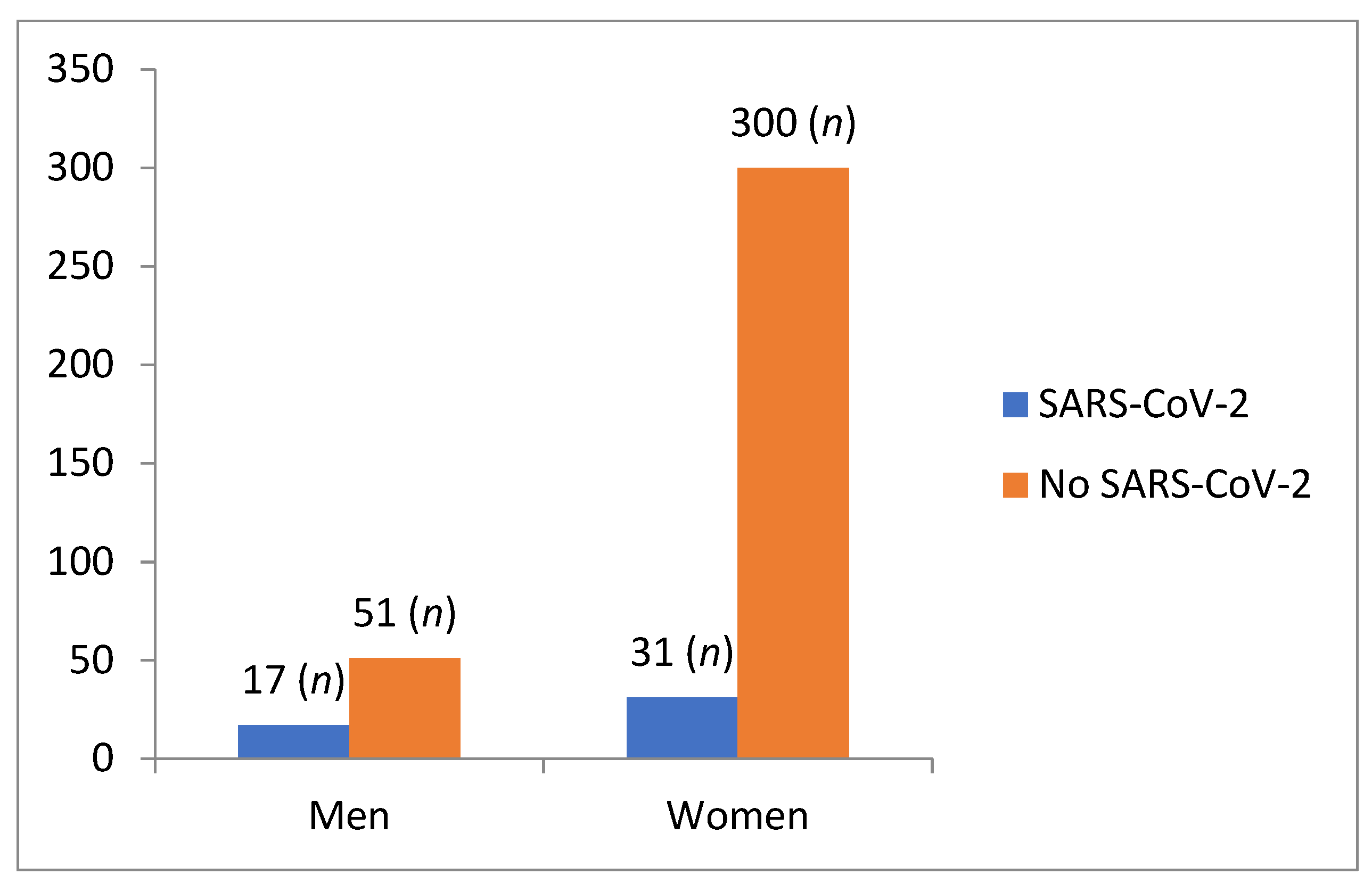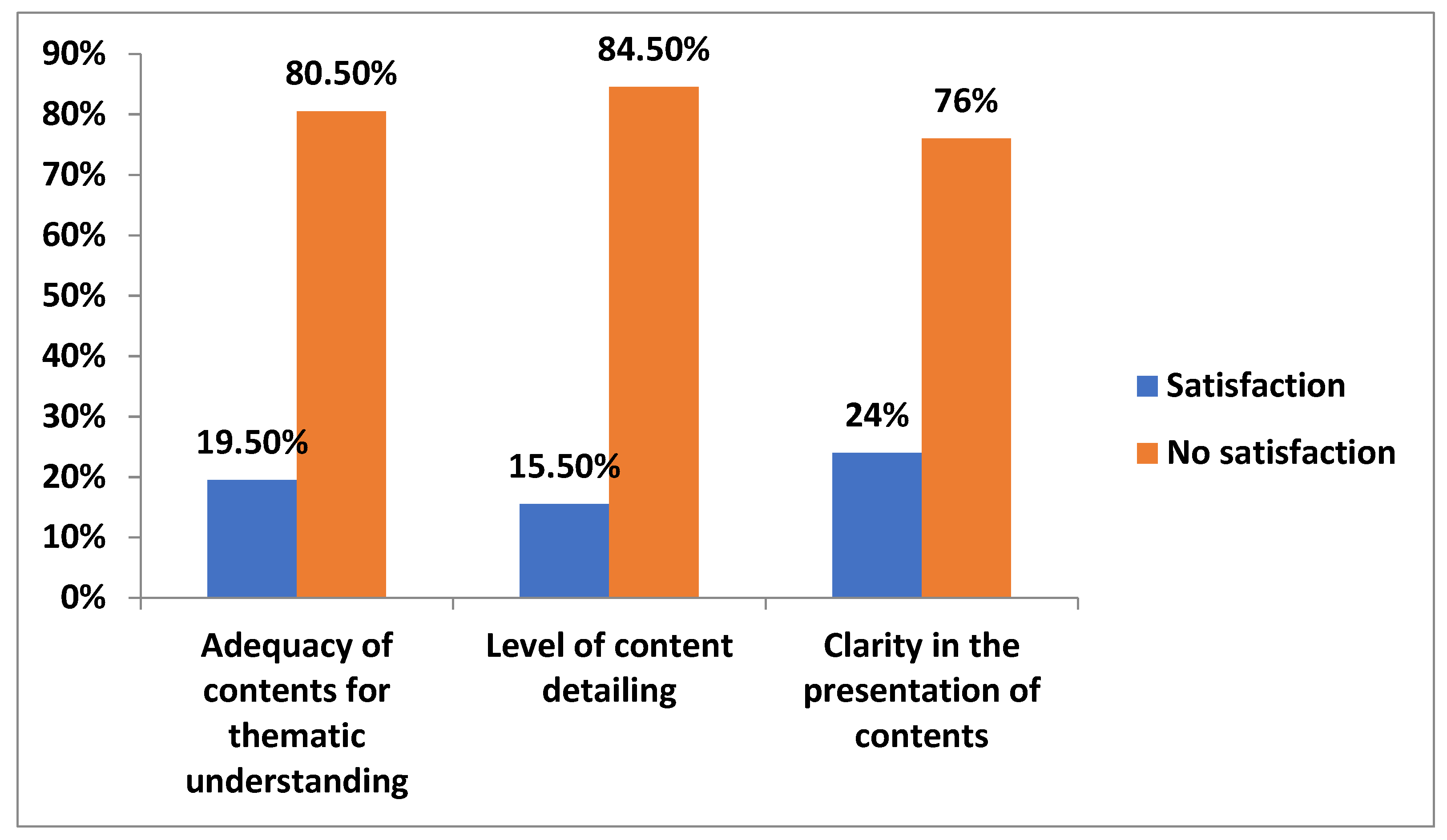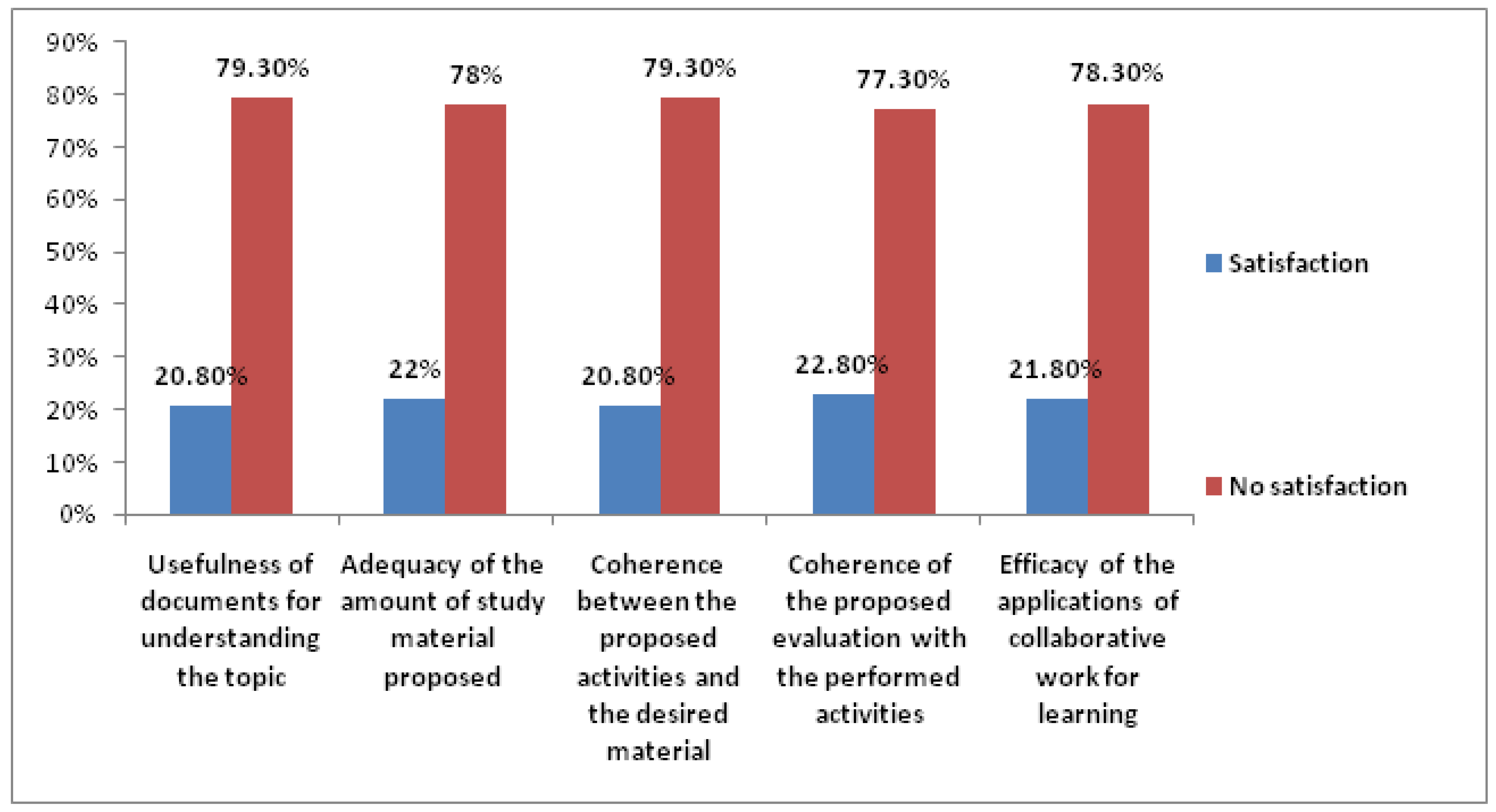Nursing Education during the SARS-CoV-2 Pandemic: Assessment of Students’ Satisfaction with e-Learning Environment
Abstract
:1. Introduction
2. Materials and Methods
2.1. Participants
2.2. Procedure
2.3. Instruments
- Item 1 (curricular aspects):
- Adequacy of content for thematic understanding.
- Level of content detail.
- Clarity in the presentation of content.
- Item 2 (didactic proposal):
- Usefulness of documents for the understanding of the topic.
- Adequacy of the amount of study material proposed.
- Coherence between the proposed activities and the desired material.
- Coherence of the proposed evaluation with the performed activities.
- Efficacy of the applications of collaborative work for learning.
- Item 3 (technological environment):
- Ease of access for the different materials.
- Item 4 (tutoring):
- Faculty response time.
- Clarity and relevance of the messages of the teacher.
2.4. Analysis of Data
- Pearson’s Chi-squared, to analyse the dependency between student satisfaction with virtual teaching and suffering from COVID-19, sex and the realization of face-to-face practical activities.
- Student’s t-test, to determine the dependency between student satisfaction with virtual teaching and age.
3. Results
3.1. Realisation of Face-to-Face Practical Activities and the Perception of Preparation for the World of Work
3.2. Prevalence of Suffering from COVID-19 among the Participants
3.3. Student Satisfaction in Terms of Curricular Aspects
3.4. Student Satisfaction with Respect to the Didactic Proposal
3.5. Student Satisfaction in Terms of the Technological Environment and Tutoring
3.6. Relationship between Student Satisfaction in Virtual Teaching and Suffering from COVID-19, Sex and Realization of Face-to-Face Practical Activities
3.7. Relationship between Student Satisfaction with Virtual Teaching and Age
4. Discussion
5. Conclusions
Supplementary Materials
Author Contributions
Funding
Institutional Review Board Statement
Informed Consent Statement
Data Availability Statement
Conflicts of Interest
References
- Balluerka, M.N.; Gómez, J.; Hidalgo, M.D.; Gorostiaga, M.A.; Espada, J.P.; Padilla, J.L.; Santed, M.Á. Las Consecuencias Psicológicas de la COVID-19 y el Confinamiento. Informe de Investigación; Servicio de Publicaciones de la Universidad del País Vasco: Bilbao, Spain, 2000; Available online: https://www.ub.edu/web/ub/ca/menu_eines/noticies/docs/Consecuencias_psicologicas_COVID-19.pdf (accessed on 10 January 2022).
- Sandín, B.; Valiente, R.M.; García-Escalera, J.; Chorot, P. Impacto psicológico de la pandemia de COVID-19: Efectos negativos y positivos en población española asociados al periodo de confinamiento nacional. Rev. Psicopatología Psicol. Clínica 2020, 25, 1–22. Available online: http://revistas.uned.es/index.php/RPPC/article/view/27569 (accessed on 8 January 2022). [CrossRef]
- Gago-Valiente, F.J.; Mendoza-Sierra, M.I.; Moreno-Sánchez, E.; Arbinaga, F.; Segura-Camacho, A. Emotional exhaustion, depersonalization, and mental health in nurses from Huelva: A cross-cutting study during the SARS-CoV-2 pandemic. Int. J. Environ. Res. Public Health 2021, 18, 7860. [Google Scholar] [CrossRef] [PubMed]
- Torres, R.; Fernández, M. La Política Económica Española y el COVID-19. Cuad. Inf. 2020, 275, 1–7. Available online: https://www.funcas.es/wp-content/uploads/Migracion/Articulos/FUNCAS_CIE/275art02.pdf (accessed on 8 January 2022).
- World Health Organization. The Jakarta Declaration: On Leading Health Promotion into the 21st Century = Déclaration de Jakarta Sur la Promotion de la Santé au XXIe Siécle; World Health Organization: Jakarta, Indonesia, 1997; Available online: https://apps.who.int/iris/handle/10665/63698 (accessed on 12 January 2022).
- Gago-Valiente, F.J.; Moreno-Sánchez, E.; Sáez-Padilla, J.; Rodríguez-Miranda, F.P. Educación Para la Salud y el Bienestar Profesional: Una Propuesta Formativa Antes el SARS-CoV-2. Ler Educação 2021, 1, 82–92. Available online: https://www.researchgate.net/publication/353915135_Educacion_para_la_salud_y_el_bienestar_profesional_una_propuesta_formativa_ante_el_SARS-COV-2 (accessed on 16 January 2022).
- Gómez, G.S.; del Castillo Saiz, G.D.; Piera, O.R.; Martinez, M.G.; Velázquez, I.C.M. Satisfacción de Educandos a Distancia en Tiempos de Pandemia. Arch. Hosp. Univ. Gen. Calixto García 2021, 9, 206–215. Available online: http://revcalixto.sld.cu/index.php/ahcgurn:nbn:de:0000-ahcg.v9i2.628 (accessed on 16 January 2022).
- Lara, R. Educación en enfermería en tiempos de pandemia: Desafíos presentes y futuros. Cienc. Enferm. 2020, 26, 1–3. [Google Scholar]
- López-Valenciano, A.; Suárez-Iglesias, D.; Sanchez-Lastra, M.A.; Ayán, C. Impact of COVID-19 Pandemic on University Students’ Physical Activity Levels: An Early Systematic Review. Front. Psychol. 2021, 11, 3787. [Google Scholar] [CrossRef]
- Rodríguez-Larrad, A.; Mañas, A.; Labayen, I.; González-Gross, M.; Espin, A.; Aznar, S.; Serrano-Sánchez, J.A.; Vera-Garcia, F.J.; González-Lamuño, D.; Ara, I.; et al. Impact of COVID-19 Confinement on Physical Activity and Sedentary Behaviour in Spanish University Students: Role of Gender. Int. J. Environ. Res. Public Health 2021, 18, 369. [Google Scholar] [CrossRef]
- Husky, M.M.; Kovess-Masfety, V.; Swendsen, J.D. Stress and anxiety among university students in France during COVID-19 mandatory confinement. Compr. Psychiatry 2020, 102, 152191. [Google Scholar] [CrossRef]
- Marques, G.; Drissi, N.; Díez, I.T.; de Abajo, B.S.; Ouhbi, S. Impact of COVID-19 on the psychological health of university students in Spain and their attitudes toward Mobile mental health solutions. Int. J. Med. Inform. 2021, 147, 104369. [Google Scholar] [CrossRef]
- Faisal, R.A.; Jobe, M.C.; Ahmed, O.; Sharker, T. Mental health status, anxiety, and depression levels of Bangladeshi university students during the COVID-19 pandemic. Int. J. Ment. Health Addict. 2021, 1–16. [Google Scholar] [CrossRef] [PubMed]
- Pérez-López, E.; Vázquez Atochero, A.; Cambero Rivero, S. Educación a distancia en tiempos de COVID-19: Análisis desde la perspectiva de los estudiantes universitarios. RIED. Rev. Educ. Distancia 2021, 24, 331–350. [Google Scholar]
- Costa, R.; Lino, M.M.; Souza, A.I.J.; Lorenzini, E.; Fernandes, G.C.M.; Brehmer, L.C.F. Enseñanza de enfermería en tiempos de COVID-19: ¿cómo reinventarla en este contexto? Texto Contexto-Enfermería 2020, 29, 1–3. [Google Scholar] [CrossRef]
- Agu, C.F.; Stewart, J.; McFarlane-Stewart, N.; Rae, T. COVID-19 pandemic effects on nursing education: Looking through the lens of a developing country. Int. Nurs. Rev. 2021, 68, 153–158. [Google Scholar] [CrossRef] [PubMed]
- Carolan, C.; Crookes, P.; McGhee, S.; Roxburgh, M. COVID 19: Disruptive impacts and transformative opportunities in undergraduate nurse education. Nurse Educ. Pract. 2021, 46, 102807. [Google Scholar] [CrossRef]
- Rodríguez-Gázquez, M. ¡Hola! ¿Me escuchan? Reflexión desde la docencia virtual en enfermería en tiempos de pandemia. J. Health NPEPS 2020, 5, 8–10. [Google Scholar] [CrossRef]
- Kang, H.Y.; Kim, H.R. Impact of blended learning on learning outcomes in the public healthcare education course: A review of flipped classroom with team-based learning. BMC Med. Educ. 2021, 21, 78. [Google Scholar] [CrossRef]
- Tabatabai, S. Simulations and virtual learning supporting clinical education during the COVID 19 pandemic. Adv. Med. Educ. Pract. 2020, 11, 513–516. [Google Scholar] [CrossRef]
- Fogg, N.; Wilson, C.; Trinka, M.; Campbell, R.; Thomson, A.; Merritt, L.; Tietze, M.; Prior, M. Transitioning from direct care to virtual clinical experiences during the COVID-19 pandemic. J. Prof. Nurs. 2020, 36, 685–691. [Google Scholar] [CrossRef]
- Chen, J.L. Online COVID Education by Nursing Students in an Assisted-Living Facility. Nurse Educ. 2021, 46, 169. [Google Scholar] [CrossRef]
- Ismaili, Y. Evaluation of students’ attitude toward distance learning during the pandemic (COVID-19): A case study of ELTE university. On Horizon 2021, 1–14. [Google Scholar] [CrossRef]
- Dost, S.; Hossain, A.; Shehab, M.; Abdelwahed, A.; Al-Nusair, L. Perceptions of medical students towards online teaching during the COVID-19 pandemic: A national cross-sectional survey of 2721 UK medical students. BMJ Open 2020, 10, e042378. [Google Scholar] [CrossRef]
- Terzi, B.; Azizoğlu, F.; Özhan, F. Factors affecting attitudes of nursing students towards distance education during the COVID-19 pandemic: A web-based cross-sectional survey. Perspect. Psychiatr. Care 2021, 1–9. [Google Scholar] [CrossRef]
- Garrison, D.R.; Anderson, T.; Archer, W. The first decade of the community of inquiry framework: A retrospective. Internet High. Educ. 2010, 13, 5–9. [Google Scholar] [CrossRef]
- Garrison, D.R.; Anderson, T. El Elearning en el Siglo XXI: Investigación y Práctica; Octaedro: Barcelona, Spain, 2005. [Google Scholar]
- Gairín Sallán, J. Las Comunidades Virtuales de Aprendizaje. 2007, p. 41. Available online: https://raco.cat/index.php/Educar/article/view/58020 (accessed on 16 January 2022).
- Hayes, B. Measuring Customer Satisfaction; ASQ Quality Press: Mistwakee, WI, USA, 1992. [Google Scholar]
- Hayes, B. Cómo Medir la Satisfacción del Cliente: Desarrollo y Utilización de Cuestionarios; Gestión 2000: Laviana, Spain, 1995. [Google Scholar]
- Hayes, B. Measuring Customer Satisfaction: Survey Design, Use, and Statistical Analysis Methods, 2nd ed.; ASQ Quality Press: Milwaukee, WI, USA, 1998. [Google Scholar]
- Oducado, R.M.; Estoque, H. Online Learning in Nursing Education During the COVID-19 Pandemic: Stress, Satisfaction, and Academic Performance. J. Nurs. Pract. 2021, 4, 143–153. [Google Scholar] [CrossRef]
- Llarena, M.; Paparo, M. Propuesta de una metodología de seguimiento y evaluación de cursos a distancia. Rev. Iberoam. Educ. 2006, 37, 1–12. [Google Scholar] [CrossRef]
- Navarro, E.R.; Arellano, E.G.R.; Galán, D.B.R.; Díaz, R.E.B. Adaptación Docente Educativa en el Contexto COVID-19: Una Revisión Sistemática. Conrado 2020, 16, 141–149. Available online: http://scielo.sld.cu/scielo.php?script=sci_arttext&pid=S1990-86442020000600141 (accessed on 16 January 2022).
- Beatriz Sayago, Z.; Chacón, M.A. Las Prácticas Profesionales en la Formación Docente: Hacia un Nuevo Diario de Ruta. Educere 2020, 10, 55–56. [Google Scholar]
- Cañadas-De-la-Fuente, G.A.; Ortega, E.; Ramirez-Baena, L.; De la Fuente-Solana, E.I.; Vargas, C.; Gómez-Urquiza, J.L. Gender, Marital Status, and Children as Risk Factors for Burnout in Nurses: A Meta-Analytic Study. Int. J. Environ. Res. Public Health 2018, 15, 2102. [Google Scholar] [CrossRef] [Green Version]
- Vargas Rubilar, N.; Oros, L.B. Stress and Burnout in Teachers During Times of Pandemic. Front. Psychol. 2021, 12, 5586. [Google Scholar] [CrossRef]
- Noda, T.; Nagaura, H.; Tsutsumi, T.; Fujita, Y.; Asao, Y.; Matsuda, A.; Satsuma, A.; Nakanishi, M.; Ohnishi, R.; Takemori, M. Cross-sectional Study of the Psychological Impact of the COVID-19 Pandemic on Undergraduate and Graduate Students in Japan. J. Affect. Disord. Rep. 2021, 6, 100282. [Google Scholar] [CrossRef]



| Sex | Suffering from COVID-19 | Realisation of Face-to-Face Practical Activities | ||||||||||
|---|---|---|---|---|---|---|---|---|---|---|---|---|
| Curricular Aspects a | Woman | Man | Yes | No | Yes | No | ||||||
| Adequacy of contents for thematic understanding | Satisfaction (%) | Satisfaction (%) | Satisfaction (%) | |||||||||
| No | Yes | No | Yes | No | Yes | No | Yes | No | Yes | No | Yes | |
| 80.7 | 19.3 | 79.7 | 20.3 | 78.7 | 21.3 | 80.8 | 19.2 | 80.2 | 19.8 | 82.1 | 17.9 | |
| Pearson’s Chi-squared | 0.033 | 0.142 | 0.130 | |||||||||
| Asymptotic significance (bilateral) | 0.856 * | 0.706 * | 0.719 * | |||||||||
| Level of content detailing | Satisfaction (%) | Satisfaction (%) | Satisfaction (%) | |||||||||
| No | Yes | No | Yes | No | Yes | No | Yes | No | Yes | No | Yes | |
| 84.9 | 15.1 | 82.6 | 17.4 | 80.3 | 19.7 | 85.2 | 14.8 | 84.1 | 15.9 | 86.6 | 13.4 | |
| Pearson’s Chi-squared | 0.228 | 0.937 | 0.263 | |||||||||
| Asymptotic significance (bilateral) | 0.633 * | 0.333 * | 0.608 * | |||||||||
| Clarity in the presentation of contents | Satisfaction (%) | Satisfaction (%) | Satisfaction (%) | |||||||||
| No | Yes | No | Yes | No | Yes | No | Yes | No | Yes | No | Yes | |
| 75.8 | 24.2 | 76.8 | 23.2 | 77 | 23 | 75.7 | 24.3 | 75.4 | 24.6 | 79.1 | 20.9 | |
| Pearson’s Chi-squared | 0.030 | 0.048 | 0.425 | |||||||||
| Asymptotic significance (bilateral) | 0.862 * | 0.826 * | 0.514 * | |||||||||
| Sex | Suffering from COVID-19 | Realisation of Face-to-Face Practical Activities | ||||||||||
|---|---|---|---|---|---|---|---|---|---|---|---|---|
| Didactic Proposal a | Woman | Man | Yes | No | Yes | No | ||||||
| Usefulness of documents for understanding the topic | Satisfaction (%) | Satisfaction (%) | Satisfaction (%) | |||||||||
| No | Yes | No | Yes | No | Yes | No | Yes | No | Yes | No | Yes | |
| 81 | 19 | 71 | 29 | 77 | 23 | 79.6 | 20.4 | 78.7 | 21.3 | 82.1 | 17.9 | |
| Pearson’s Chi-squared | 3.439 | 0.202 | 0.395 | |||||||||
| Asymptotic significance (bilateral) | 0.064 * | 0.653 * | 0.530 * | |||||||||
| Adequacy of the amount of study material proposed | Satisfaction (%) | Satisfaction (%) | Satisfaction (%) | |||||||||
| No | Yes | No | Yes | No | Yes | No | Yes | No | Yes | No | Yes | |
| 79.8 | 20.2 | 69.6 | 30.4 | 78.7 | 21.3 | 77.8 | 22.2 | 78.1 | 21.9 | 77.6 | 22.4 | |
| Pearson’s Chi-squared | 3.457 | 0.023 | 0.007 | |||||||||
| Asymptotic significance (bilateral) | 0.063 * | 0.879 * | 0.993 * | |||||||||
| Coherence between the proposed activities and desired material | Satisfaction (%) | Satisfaction (%) | Satisfaction (%) | |||||||||
| No | Yes | No | Yes | No | Yes | No | Yes | No | Yes | No | Yes | |
| 78.5 | 21.5 | 82.6 | 17.4 | 80.3 | 19.7 | 79 | 21 | 79.3 | 20.7 | 79.1 | 20.9 | |
| Pearson’s Chi-squared | 0.572 | 0.056 | 0.001 | |||||||||
| Asymptotic significance (bilateral) | 0.449 * | 0.813 * | 0.974 * | |||||||||
| Coherence of the proposed evaluation with the performed activities | Satisfaction (%) | Satisfaction (%) | Satisfaction (%) | |||||||||
| No | Yes | No | Yes | No | Yes | No | Yes | No | Yes | No | Yes | |
| 77.6 | 22.4 | 75.4 | 24.6 | 75.4 | 24.6 | 77.5 | 22.5 | 76.3 | 23.7 | 82.1 | 17.9 | |
| Sex | Suffering from COVID-19 | Realisation of Face-to-Face Practical Activities | ||||||||||
|---|---|---|---|---|---|---|---|---|---|---|---|---|
| Technological Environment a | Woman | Man | Yes | No | Yes | No | ||||||
| Ease of access to the different materials | Satisfaction | Satisfaction | Satisfaction | |||||||||
| No | Yes | No | Yes | No | Yes | No | Yes | No | Yes | No | Yes | |
| 73.4 | 26.6 | 65.2 | 34.8 | 65.6 | 34.4 | 73.1 | 26.9 | 70 | 30 | 82.1 | 17.9 | |
| Pearson’s Chi-squared | 1.903 | 1.441 | 4.064 | |||||||||
| Asymptotic significance (bilateral) | 0.168 * | 0.230 * | 0.044 * | |||||||||
| Sex | Suffering from COVID-19 | Realisation of Face-to-Face Practical Activities | ||||||||||
|---|---|---|---|---|---|---|---|---|---|---|---|---|
| Tutoring a | Woman | Man | Yes | No | Yes | No | ||||||
| Faculty response time | Satisfaction (%) | Satisfaction (%) | Satisfaction (%) | |||||||||
| No | Yes | No | Yes | No | Yes | No | Yes | No | Yes | No | Yes | |
| 56.8 | 43.2 | 59.4 | 40.6 | 60.7 | 39.3 | 56.5 | 43.5 | 56.8 | 43.2 | 59.7 | 40.3 | |
| Chi-Cuadrado De Pearson | 0.160 | 0.363 | 0.198 | |||||||||
| Asymptotic significance (bilateral) | 0.689 * | 0.547 * | 0.657 * | |||||||||
| Clarity and relevance of the messages of the faculty | Satisfaction (%) | Satisfaction (%) | Satisfaction (%) | |||||||||
| No | Yes | No | Yes | No | Yes | No | Yes | No | Yes | No | Yes | |
| 75.5 | 24.5 | 71 | 29 | 77 | 23 | 74.3 | 25.7 | 74.2 | 25.8 | 77.6 | 22.4 | |
| Pearson’s Chi-squared | 0.616 | 0.213 | 0.349 | |||||||||
| Asymptotic significance (bilateral) | 0.432 * | 0.645 * | 0.555 * | |||||||||
| Age | ||
|---|---|---|
| Technological Environment a | X− | |
| No | Yes | |
| Ease of access to the different materials | 23.38 | 23.04 |
| Student’s t-test | 0.759 | |
| Asymptotic significance (bilateral) | 0.448 * | |
Publisher’s Note: MDPI stays neutral with regard to jurisdictional claims in published maps and institutional affiliations. |
© 2022 by the authors. Licensee MDPI, Basel, Switzerland. This article is an open access article distributed under the terms and conditions of the Creative Commons Attribution (CC BY) license (https://creativecommons.org/licenses/by/4.0/).
Share and Cite
Moreno-Sánchez, E.; Merino-Godoy, M.-d.-l.-Á.; Piñero-Claros, S.; Santiago-Sánchez, A.; Del-Campo-Jiménez, Á.; Mariscal-Pérez, L.; Rodríguez-Miranda, F.d.P.; Costa, E.I.; Gago-Valiente, F.-J. Nursing Education during the SARS-CoV-2 Pandemic: Assessment of Students’ Satisfaction with e-Learning Environment. Int. J. Environ. Res. Public Health 2022, 19, 2023. https://doi.org/10.3390/ijerph19042023
Moreno-Sánchez E, Merino-Godoy M-d-l-Á, Piñero-Claros S, Santiago-Sánchez A, Del-Campo-Jiménez Á, Mariscal-Pérez L, Rodríguez-Miranda FdP, Costa EI, Gago-Valiente F-J. Nursing Education during the SARS-CoV-2 Pandemic: Assessment of Students’ Satisfaction with e-Learning Environment. International Journal of Environmental Research and Public Health. 2022; 19(4):2023. https://doi.org/10.3390/ijerph19042023
Chicago/Turabian StyleMoreno-Sánchez, Emilia, María-de-los-Ángeles Merino-Godoy, Sara Piñero-Claros, Alba Santiago-Sánchez, Ángela Del-Campo-Jiménez, Laura Mariscal-Pérez, Francisco de Paula Rodríguez-Miranda, Emilia Isabel Costa, and Francisco-Javier Gago-Valiente. 2022. "Nursing Education during the SARS-CoV-2 Pandemic: Assessment of Students’ Satisfaction with e-Learning Environment" International Journal of Environmental Research and Public Health 19, no. 4: 2023. https://doi.org/10.3390/ijerph19042023
APA StyleMoreno-Sánchez, E., Merino-Godoy, M.-d.-l.-Á., Piñero-Claros, S., Santiago-Sánchez, A., Del-Campo-Jiménez, Á., Mariscal-Pérez, L., Rodríguez-Miranda, F. d. P., Costa, E. I., & Gago-Valiente, F.-J. (2022). Nursing Education during the SARS-CoV-2 Pandemic: Assessment of Students’ Satisfaction with e-Learning Environment. International Journal of Environmental Research and Public Health, 19(4), 2023. https://doi.org/10.3390/ijerph19042023









